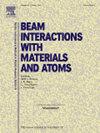镍掺杂氧化镁纳米颗粒:合成、表征和伽马辐射中的热释光剂量学特征
IF 1.4
3区 物理与天体物理
Q3 INSTRUMENTS & INSTRUMENTATION
Nuclear Instruments & Methods in Physics Research Section B-beam Interactions With Materials and Atoms
Pub Date : 2025-07-10
DOI:10.1016/j.nimb.2025.165782
引用次数: 0
摘要
采用共沉淀法合成了新型的ni掺杂氧化镁纳米颗粒,并对掺杂浓度和退火条件进行了优化。与以往的研究不同,本研究系统地研究了Ni浓度和热处理对合成的MgO: Ni纳米颗粒热释光(TL)性能的影响。对制备样品的晶体性质、形貌、组成和结构进行了表征。XRD分析表明,MgO相为纯立方MgO相,晶粒尺寸小于50 nm。经过20 Gy γ辐照后,掺杂1 mol% Ni并在700℃退火的样品显示出最高的积分TL信号。该材料显示出高达1000 Gy的线性伽马剂量响应,并且在30天内具有出色的信号稳定性。采用基于一般阶动力学模型的曲线拟合方法确定了动力学参数。这些发现突出了MgO: Ni纳米颗粒作为高剂量剂量测定的高效荧光粉的潜力。本文章由计算机程序翻译,如有差异,请以英文原文为准。
Nickel doped magnesium oxide nanoparticles: synthesis, characterization, and thermoluminescence dosimetry features in gamma irradiation
The novel Ni-doped magnesium oxide nanoparticles were synthesized using the co-precipitation technique and optimized across various dopant concentrations and annealing conditions. Unlike previous studies, this work systematically investigates the influence of Ni concentration and thermal treatment on thermoluminescence (TL) properties of the synthesized MgO: Ni nanoparticles. The crystalline properties, morphology, composition, and structure of the fabricated samples were characterized. XRD analysis revealed a pure cubic MgO phase with crystallite sizes below 50 nm. After 20 Gy gamma irradiation, the sample doped with 1 mol% Ni and annealed at 700 °C exhibited the highest integrated TL signal. The material showed a linear gamma dose response up to 1000 Gy and excellent signal stability over 30 days. Kinetic parameters were determined using curve fitting based on a general-order kinetic model. These findings highlight the potential of MgO: Ni nanoparticles as efficient phosphor for high dose dosimetry.
求助全文
通过发布文献求助,成功后即可免费获取论文全文。
去求助
来源期刊
CiteScore
2.80
自引率
7.70%
发文量
231
审稿时长
1.9 months
期刊介绍:
Section B of Nuclear Instruments and Methods in Physics Research covers all aspects of the interaction of energetic beams with atoms, molecules and aggregate forms of matter. This includes ion beam analysis and ion beam modification of materials as well as basic data of importance for these studies. Topics of general interest include: atomic collisions in solids, particle channelling, all aspects of collision cascades, the modification of materials by energetic beams, ion implantation, irradiation - induced changes in materials, the physics and chemistry of beam interactions and the analysis of materials by all forms of energetic radiation. Modification by ion, laser and electron beams for the study of electronic materials, metals, ceramics, insulators, polymers and other important and new materials systems are included. Related studies, such as the application of ion beam analysis to biological, archaeological and geological samples as well as applications to solve problems in planetary science are also welcome. Energetic beams of interest include atomic and molecular ions, neutrons, positrons and muons, plasmas directed at surfaces, electron and photon beams, including laser treated surfaces and studies of solids by photon radiation from rotating anodes, synchrotrons, etc. In addition, the interaction between various forms of radiation and radiation-induced deposition processes are relevant.

 求助内容:
求助内容: 应助结果提醒方式:
应助结果提醒方式:


